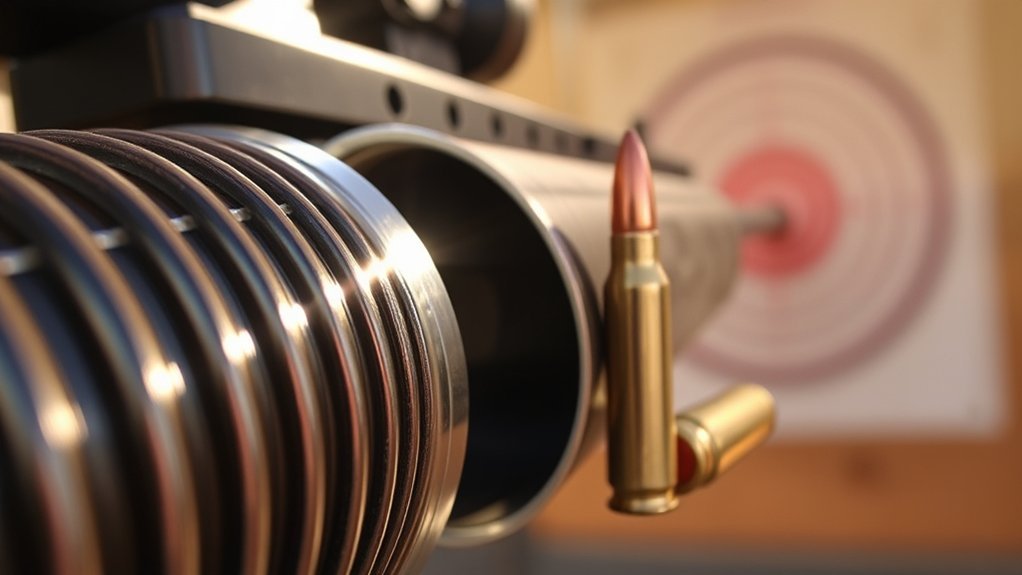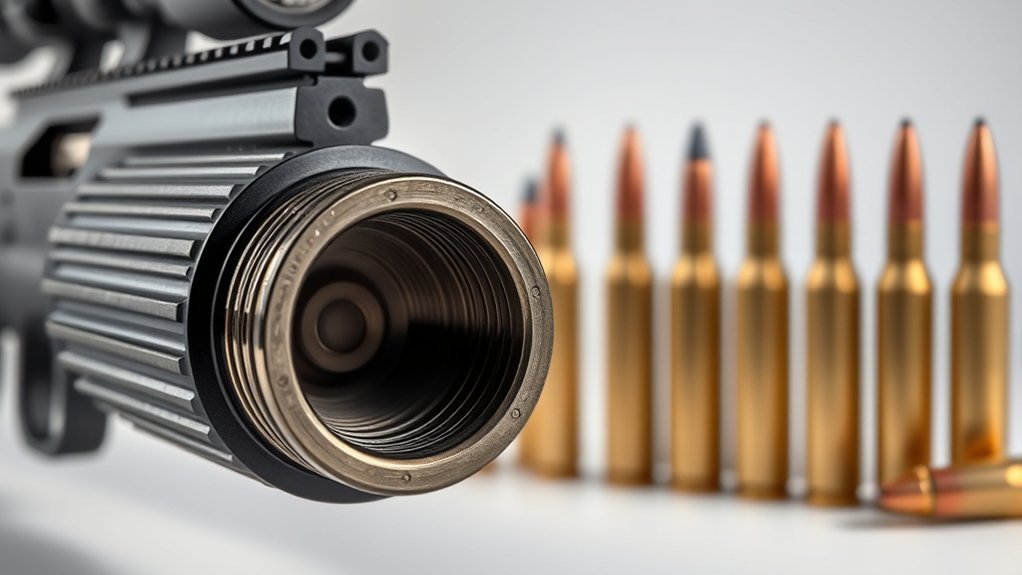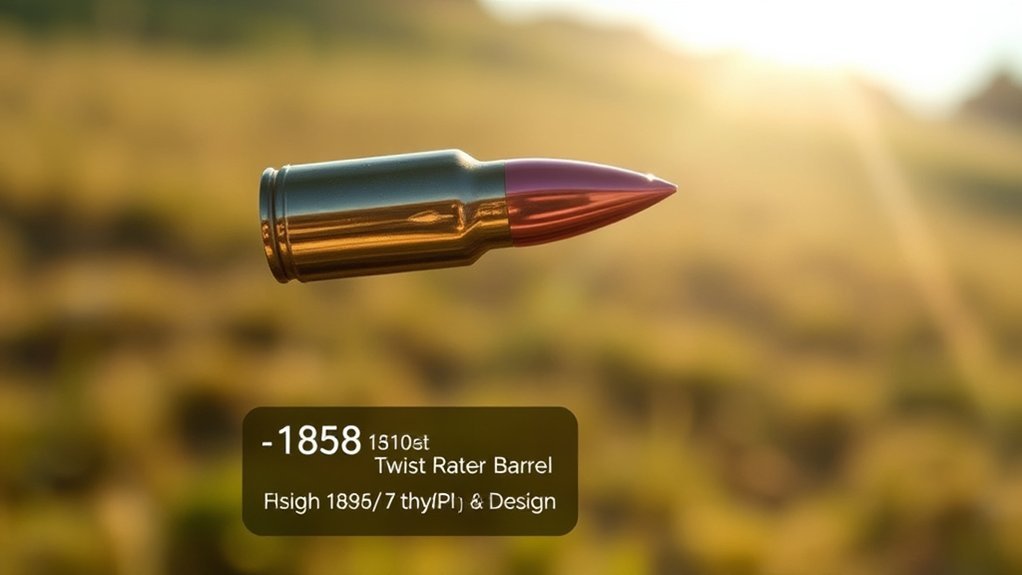Understanding twist rate is essential for anyone serious about shooting accuracy. It directly affects how well a bullet stabilizes in flight, influencing your performance. The relationship between twist rate, bullet length, and weight can make or break your shot. Choosing the right combination isn’t just a matter of preference; it’s critical for achieving precision. So, what factors should you consider when selecting your twist rate? Let’s explore this intricate balance further.
What Is Twist Rate?

Twist rate refers to the rate at which the rifling in a firearm’s barrel rotates the bullet as it travels down the bore. It’s typically expressed as a ratio, such as 1:10, indicating that the bullet completes one full rotation for every ten inches it travels. The twist rate considerably influences bullet stabilization; a faster twist stabilizes longer, heavier bullets while a slower twist may suffice for shorter, lighter projectiles. This stability is vital for accuracy, as a well-stabilized bullet maintains a consistent trajectory and minimizes yaw. Choosing the right twist rate for your ammunition and shooting conditions is essential for ideal performance, ensuring that your firearm operates effectively at various ranges and conditions.
How Twist Rate Is Measured

Measuring twist rate involves determining the distance the bullet travels in inches for one complete rotation of the rifling. Typically, you’ll see twist rates expressed as a ratio, such as 1:10 or 1:12. This notation indicates the inches required for one full turn of the rifling. For instance, a 1:10 twist means the bullet makes one complete revolution over 10 inches of travel. To measure this accurately, you can use a specialized tool or caliper to assess the rifling’s pitch. Alternatively, you might employ a bullet drop test, where you fire a bullet and measure the distance it travels before hitting a target, allowing you to calculate the twist rate based on the bullet’s stability and performance.
The Science Behind Bullet Stabilization

To understand bullet stabilization, you need to grasp the principles of gyroscopic stability. The twist rate of your barrel directly influences how effectively the bullet maintains its trajectory, while bullet design also plays a vital role in this dynamic. By analyzing these factors, you can optimize performance and accuracy in your shooting.
Gyroscopic Stability Principles
While many factors influence bullet performance, gyroscopic stability stands out as a critical principle in ensuring accuracy during flight. This stability arises from the bullet’s rotation around its longitudinal axis, which prevents deviations caused by external forces. When you understand the gyroscopic effect, you can appreciate how it maintains a bullet’s flight path.
| Factor | Impact on Stability |
|---|---|
| Spin Rate | Higher rates enhance stability |
| Bullet Length | Longer bullets are more stable |
| Weight Distribution | Even distribution improves control |
| Environmental Factors | Wind can disrupt stability |
| Barrel Twist Rate | Must match bullet design |
Importance of Twist Rate
Understanding the importance of twist rate is crucial for achieving ideal bullet stabilization. The twist rate directly affects how well your bullet maintains its trajectory and accuracy throughout flight. A proper twist rate guarantees that the bullet spins at the right velocity, preventing it from yawing or tumbling. Here are some key points to reflect on:
- Affects gyroscopic stability and accuracy.
- Determines the compatibility with different bullet weights.
- Influences drag and energy retention over distance.
- Impacts performance in various environmental conditions.
- Essential for optimizing barrel length and caliber combination.
Bullet Design Considerations
Bullet design plays a pivotal role in stabilization, directly influencing how effectively a bullet performs in flight. You’ll find that factors such as bullet shape, weight distribution, and construction materials can greatly impact its aerodynamic efficiency. A streamlined profile minimizes drag, while a heavier base can enhance stability by shifting the center of mass rearward. Additionally, the bullet’s length relative to its diameter affects how it interacts with the rifling, which in turn affects the gyroscopic stability during flight. Optimizing these design elements guarantees that the bullet can maintain a true trajectory, effectively delivering energy upon impact. By understanding these considerations, you can better appreciate the intricate balance between design and performance in bullet stabilization.
Effects of Twist Rate on Bullet Performance
Your choice of twist rate considerably influences bullet accuracy and overall performance. A proper twist ratio stabilizes the projectile, enhancing its flight path and precision. Understanding these effects can help you optimize your firearm for specific applications.
Impact on Accuracy
While many factors influence a firearm’s accuracy, the twist rate of a barrel plays an essential role in stabilizing a projectile during flight. A properly matched twist rate guarantees that the bullet remains stable, enhancing accuracy. When the twist rate isn’t ideal, you may experience:
- Increased bullet yaw, leading to erratic flight paths.
- Reduced terminal performance due to insufficient stabilization.
- A higher likelihood of keyholing, impacting precision.
- Variances in ballistic coefficient, affecting distance accuracy.
- Greater sensitivity to environmental factors like wind.
Understanding the relationship between twist rate and bullet performance allows you to make informed choices about ammunition and firearm setup, ultimately enhancing your shooting accuracy and effectiveness in the field.
Optimal Twist Ratios
Finding the ideal twist ratio for a specific bullet is fundamental for maximizing performance and accuracy. The twist rate directly influences stabilization, which affects trajectory, velocity retention, and overall terminal performance. A faster twist rate can stabilize longer, heavier bullets, improving their ability to maintain a point of impact at distance. Conversely, a slower twist may suit lighter, shorter bullets, enhancing their accuracy at shorter ranges. Understanding the bullet’s length, weight, and velocity is critical when determining the best twist rate. Manufacturers often provide recommendations, but testing in your specific firearm is essential for practical validation. By fine-tuning the twist rate to match your ammunition, you’ll achieve superior accuracy and consistency, ensuring every shot counts.
Choosing the Right Twist Rate for Your Caliber
Selecting the appropriate twist rate for your caliber plays a crucial role in achieving ideal bullet stabilization and accuracy. A mismatch can lead to decreased performance, so understanding your needs is indispensable. Consider the following factors when choosing your twist rate:
- Bullet weight: Heavier bullets often require faster twist rates for stabilization.
- Bullet length: Longer bullets typically need a higher twist rate due to increased gyroscopic stability.
- Velocity: Faster velocities can affect stabilization; verify your twist rate complements your muzzle velocity.
- Intended use: Target shooting, hunting, or tactical applications may have different stabilization requirements.
- Caliber specifics: Each caliber has recommended twist rates; research your caliber’s recommendations for best results.
The Role of Bullet Length and Weight
Bullet length and weight are critical factors that significantly influence stabilization and accuracy. A longer bullet typically requires a faster twist rate to maintain gyroscopic stability, as its increased surface area can induce more drag and yaw during flight. Conversely, heavier bullets also necessitate specific twist rates; their mass can generate greater inertia, affecting stabilization. It’s essential to match bullet specifications with your rifle’s twist rate for peak performance. If the twist rate is too slow for the bullet’s length or weight, you may experience key issues like tumbling or inaccurate trajectories. Consequently, understanding these dynamics allows you to make informed choices, enhancing your accuracy and overall shooting experience. Always consider both length and weight when selecting ammunition.
Common Myths About Twist Rate
Understanding bullet specifications is just the beginning; many misconceptions surround twist rates that can lead to confusion. Here are some common myths:
Misunderstanding twist rates can lead to confusion; debunking common myths is essential for improved shooting performance.
- Faster twist always means better accuracy: A twist rate must match the bullet’s characteristics for peak performance.
- All bullets stabilize with the same twist rate: Bullet length and weight considerably influence stabilization.
- You can’t change your twist rate: Barrel replacement is possible to accommodate different bullet types.
- Twist rate affects velocity: Twist rate doesn’t impact bullet speed; it influences stabilization.
- Heavier bullets require faster twist rates: While this is often true, it’s not a strict rule; various factors play a role.
Being aware of these myths helps you better understand twist rates and their actual impact on shooting performance.
Practical Tips for Improving Shooting Accuracy
While achieving high shooting accuracy can be challenging, implementing specific techniques can greatly enhance your performance. Start by ensuring a consistent grip and stance; this foundational stability minimizes movement. Next, focus on your trigger control—apply steady pressure without jerking. Regularly practice breath control; inhaling and exhaling slowly can help you maintain composure during the shot. Additionally, familiarize yourself with your rifle’s twist rate and bullet type; this knowledge can aid in selecting the best ammunition for your setup. Don’t overlook environmental factors; wind and temperature can notably impact trajectory. Finally, maintain your equipment; a clean barrel and properly adjusted sights are essential for consistent precision. By systematically addressing these elements, you’ll elevate your shooting accuracy considerably.
Conclusion
Understanding twist rate is essential for achieving accuracy, enhancing stability, and optimizing performance. By selecting the right twist rate for your caliber, you improve not just your bullet’s trajectory but also your overall shooting experience. Recognizing the relationship between bullet length, weight, and twist rate can elevate your precision. Don’t overlook common myths; stay informed and make educated choices. Ultimately, mastering twist rate empowers you to shoot with confidence, precision, and consistency.

